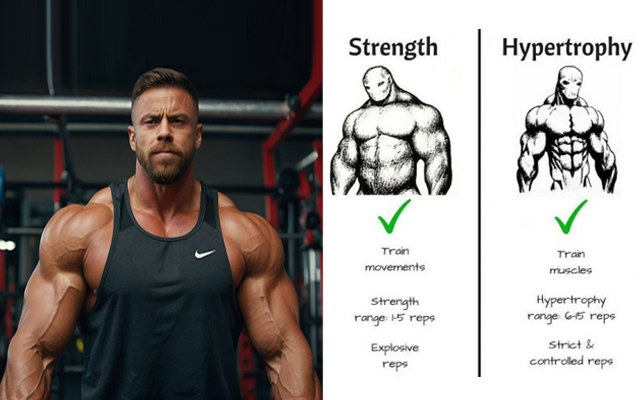Let’s dive into the fascinating world of hypertrophy training and explore the optimal sets and reps for building muscle size. Whether you’re a seasoned lifter or just starting out, understanding these principles can significantly impact your gains.
Difference Between Reps Versus Sets
Let's break down the fundamental concepts of reps and sets in weight training:
1. Reps (Repetitions):
- Definition: Reps represent the number of times you perform a specific exercise.
- Example: If you do six bicep curls, that's six reps.
- Purpose: Reps allow you to track how many times you repeat an exercise during each set.
- Importance: The number of reps influences how each set affects your muscles.
2. Sets:
- Definition: Sets refer to the consecutive reps you perform without rest.
- Example: If your trainer instructs you to do "2 sets of 10 reps," it means performing 10 repetitions, resting for one minute, and then doing another 10 repetitions.
- Purpose: Sets organize your workout by grouping reps together.
- Importance: Each set concludes with a rest period, allowing your muscles to recover before moving on to the next set or exercise.
In summary, reps are the individual movements you perform, while sets group those reps together. Understanding and manipulating these variables can significantly impact your muscle growth, strength, and endurance during your training sessions. Happy lifting!
What Is Hypertrophy Training?
Hypertrophy training is a specialized style of resistance training designed specifically to stimulate muscle growth. Whether you're aiming for aesthetics, strength, athleticism, or overall health, hypertrophy training can be tailored to suit your goals. Let's dive into the details:
Understanding Hypertrophy Training
1. Muscle Hypertrophy:
- Definition: Muscle hypertrophy refers to the process of increasing muscle size.
- Purpose: Hypertrophy training aims to maximize muscle growth by challenging your muscles through targeted exercises.
2. Different Goals, Same Approach:
- Strength: Bigger muscles have greater strength potential. Powerlifters and strength athletes use hypertrophy training to build muscle mass.
- Athleticism: Explosive power and momentum are enhanced with larger muscles. Olympic weightlifters, athletes, and fighters benefit from muscle growth.
- Aesthetics: Building bigger muscles, especially in the upper body, improves appearance and attractiveness.
- Health: More muscle relative to fat improves health markers and reduces overall mortality risk.
3. Principles of Hypertrophy Training:
- Resistance Training: Engage in weightlifting or resistance exercises.
- Progressive Overload: Gradually increase weights to challenge your muscles.
- Balanced Approach: Combine compound (multi-joint) and isolation (single-joint) exercises.
4. Choosing the Right Exercises:
- Compound Lifts: These involve multiple muscle groups. Examples include squats, deadlifts, and bench presses.
- Isolation Lifts: Target specific muscles. Bicep curls and leg extensions are examples.
5. Reps and Sets:
- Repetitions (Reps): The number of times you perform an exercise in one set.
- Sets: Consecutive reps without rest. Balance the number of challenging sets.
6. Training Frequency and Intensity:
- Frequency: Train often enough to maintain consistency.
- Intensity: Work hard enough to stimulate muscle growth.
- Rest Between Sets: Allow sufficient recovery time.
7. Efficiency Matters:
- Efficient Workouts: Optimize your routine for effectiveness.
- Balanced Nutrition: Fuel your muscles for growth.
- Recovery: Prioritize rest and sleep.
In summary, hypertrophy training is about intentional muscle growth. Customize your approach based on your goals, and enjoy the journey toward a stronger, healthier you!
How Many Sets and Reps You Need to Build Muscle
Let's dive into the fascinating world of hypertrophy training and explore the optimal sets and reps for building muscle size. Whether you're a seasoned lifter or just starting out, understanding these principles can significantly impact your gains.
The Science Behind Hypertrophy
Before we delve into the specifics, let's grasp the basics. Hypertrophy refers to the process of increasing muscle size. When you lift weights, your muscles adapt by growing larger. To achieve this, we need to manipulate certain training variables, including sets and reps.
1. Sets and Reps Explained
- Sets: These represent the total number of complete rounds of repetitions you perform in a workout. For instance, if you do three rounds of squats, each consisting of five reps, that's three sets of five reps.
- Reps (Repetitions): Reps make up one set. The range can vary from low (e.g., 1-3 reps) to high (as many as you desire).
2. General Guidelines for Hypertrophy Training
Here are some widely accepted guidelines for hypertrophy training. Remember that these apply to most beginners and intermediate lifters:
1. Maximal Strength/Power:
- Total Working Sets: 3-5 sets
- Repetition Ranges: 1-3 reps
- Training Intensity (as a percentage of your one-rep max): 85-100%
- Note: This range is more relevant for advanced athletes.
2. Functional Strength and Hypertrophy:
- Total Working Sets: 4-6 sets
- Repetition Ranges: 4-6 reps
- Training Intensity: 75-85%
- Why It Works: Balancing strength and muscle growth.
3. General Hypertrophy (Ideal for most lifters):
- Total Working Sets: 3-5 sets
- Repetition Ranges: 7-10 reps
- Training Intensity: 65-75%
- Why It Works: Promotes muscle size without excessive fatigue.
3. Muscular Endurance:
- Total Working Sets: 2-4 sets
- Repetition Ranges: 11+ reps
- Training Intensity: Less than 60%
- Why It Works: Enhances endurance and stamina.
4. Tempo and Rest Periods
- Tempo: Aim for a controlled lifting tempo (e.g., 2 seconds up, 2 seconds down).
- Rest Between Sets: Typically 30 to 90 seconds.
Remember: consistency and progressive overload are key. Adjust your sets and reps based on your individual goals and preferences. Whether you're chasing aesthetics or functional strength, tailor your training to suit your journey. Happy lifting!







0 Comments